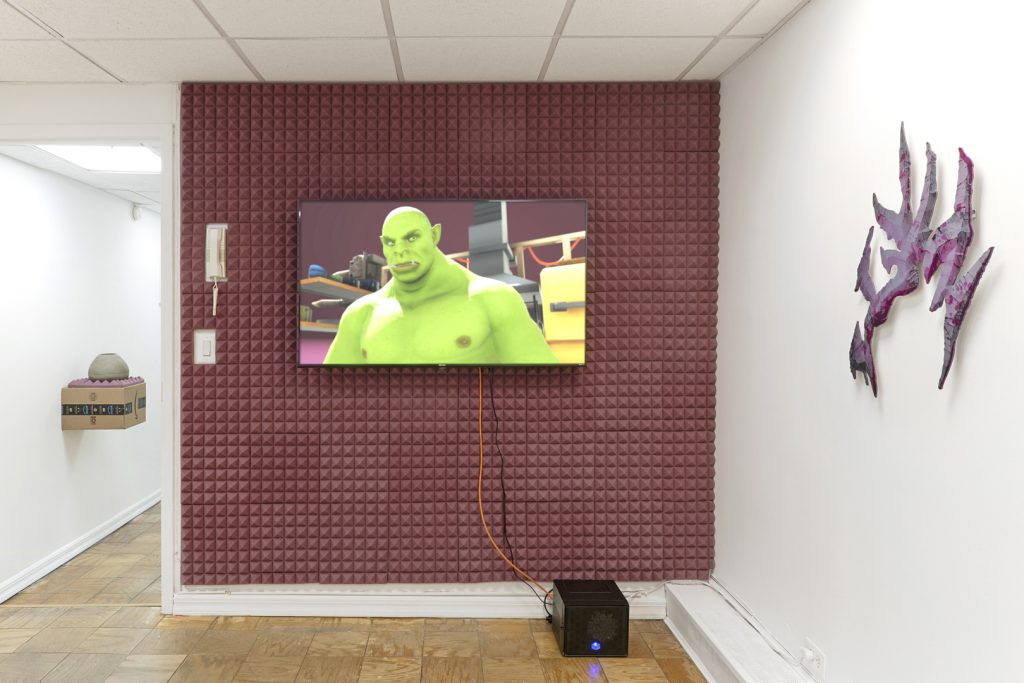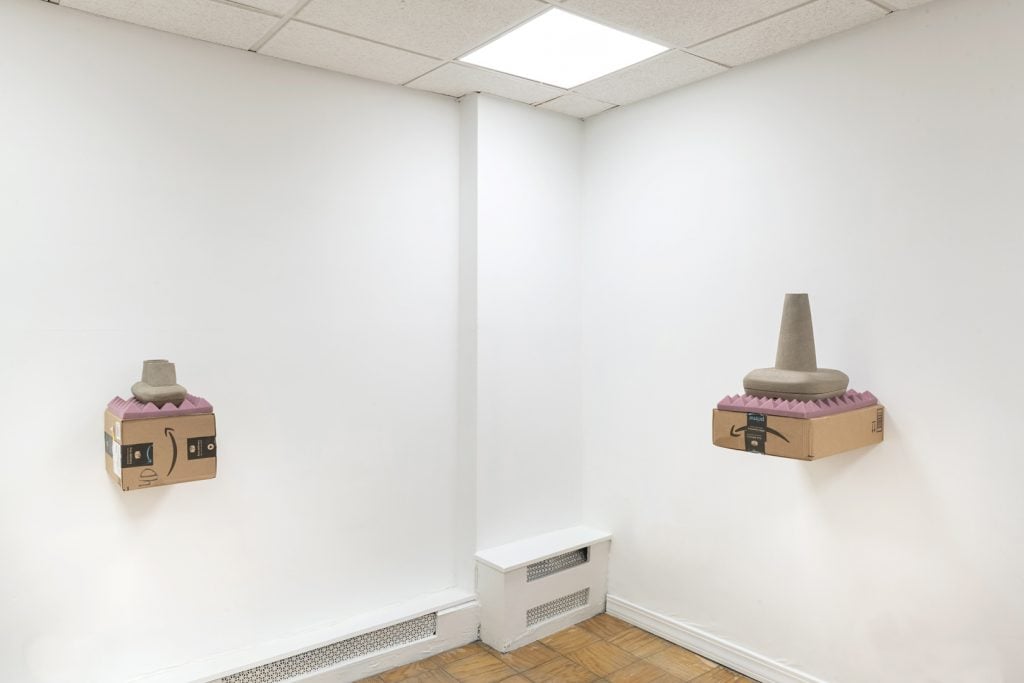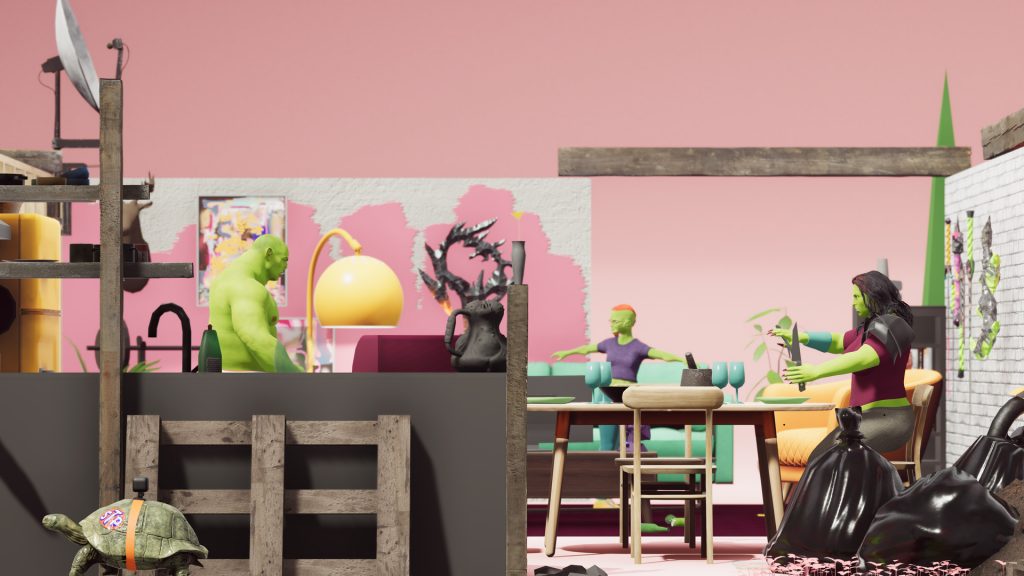On View
What Can a Family of Simulated Orks in an Art Gallery Teach Us About Life in Mark Zuckerberg’s Metaverse? A Lot, Actually
Theo Triantafyllidis's show includes two live simulations and an opera based on Mark Zuckerberg’s eerie Meta video.

Theo Triantafyllidis's show includes two live simulations and an opera based on Mark Zuckerberg’s eerie Meta video.

Taylor Dafoe

“The feeling of presence: this is the defining quality of the metaverse.”
So begins an audio composition in Theo Triantafyllidis’s new exhibition “The Metaverse and How We’ll Build it Together” at Meredith Rosen Gallery. That paradoxical line as well as others in the recording—which was co-designed by musician Holly Waxwing and blasts from inside ceramic pots installed on old Amazon boxes—were culled from the video Facebook released upon rebranding itself to Meta, an eerie piece of technocratic propaganda that was, somewhat ironically, lampooned to death on social media last fall.
Like many, Triantafyllidis—an artist who builds virtual worlds to interrogate our lived-in, physical one—found the video unsettling.
“There is this very bizarre conflict between reality and fiction—between this totally utopian, almost completely tone-deaf, representation of our own lives that Mark Zuckerberg seems to have in his mind versus the banal reality of our online experience,” the artist said over video chat recently, Zooming in from Athens, Greece, where he was born and raised. (He’s primarily based in LA.)

An installation view of Theo Triantafyllidis’s exhibition “The Metaverse and How We’ll Build It Together,” 2022 at Meredith Rosen Gallery, New York. Photo: Adam Reich.
“Banal” is a funny word for the artist to use, given the way he illustrates that disjunction between fiction and reality in the second half of the exhibition. Two live simulations—that is, video games controlled by AI rather than human button-pressing—play out on a pair of screens.
The first is populated by a family of tech-obsessed orks. Operating by a code similar to that which drives The Sims, the creatures mindlessly perform a series of repetitive tasks in their virtual home as various catastrophes slowly destroy the world around them.
One ork sprawls before the TV, for instance, while another texts atop a toilet or surfs the web. A tortoise with a camera strapped to its back rides a Roomba, or at least tries to, as his weight keeps the robotic vacuum in place—a clever metaphor, perhaps, for how technology both speeds up our lives and keeps them in place. A fire in the kitchen blazes the whole time.

A still from Theo Triantafyllidis’s Ork Haus (2022). Courtesy of the artist.
The orks look more like Shrek than those of the Lord of the Rings trilogy, but that’s not to say they’re all cute and cuddly. Triantafyllidis’s creatures are crude and vulgar; that’s why he chose them as his avatars. Within gaming communities, the artist explained, there’s a debate about orks, with some saying they’ve been villainized in popular culture through the coded racial attributes we’ve chosen to assign to them. For Triantafyllidis, the idea relates to the radicalization pipeline, or the theory that the algorithms driving social media platforms inherently push people to extremist views.
Radicalization Pipeline is also the name of the second simulation in the show. Whereas the first plays out a domestic simulation, the second is all-out war. Humans and monsters alike fight, die, decompose, and respawn in an endless, self-perpetuating loop of violence on a blank battlefield.
“The more you look at the work the more you realize how stuck these characters are in the simulation,” Triantafyllidis said.
The game-like war scene may look like it exists in a different world than the Zuckerberg-themed sound installation found in the room opposite, but for the artist, there’s a line to be drawn between the cycle metaphorized in the simulation and Facebook/Meta’s vision.
“I think there’s a direct link between the radicalization pipeline and this utopian aura that this new video tried to present, offering up this new dream to look for during the hellscape situation that we’re in right now,” Triantafyllidis concluded.
“Theo Triantafyllidis: The Metaverse and How We’ll Build it Together” is on view now through February 26, 2022 at Meredith Rosen Gallery in New York.